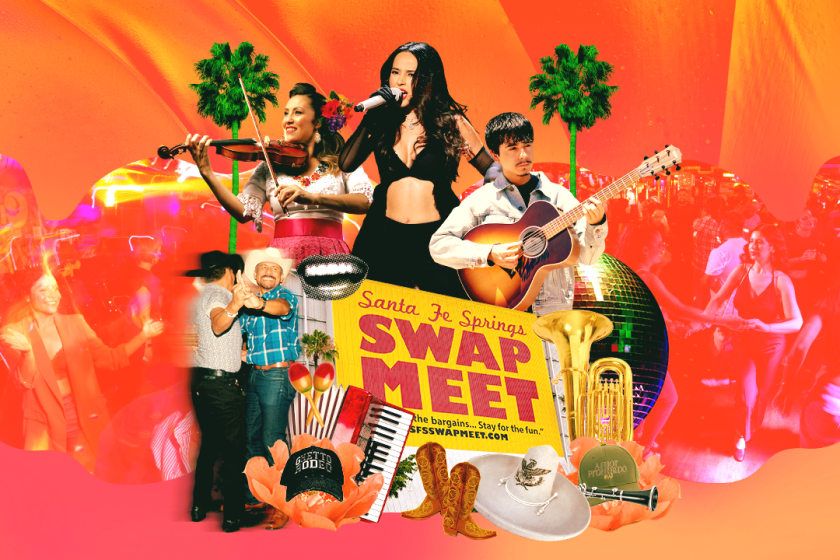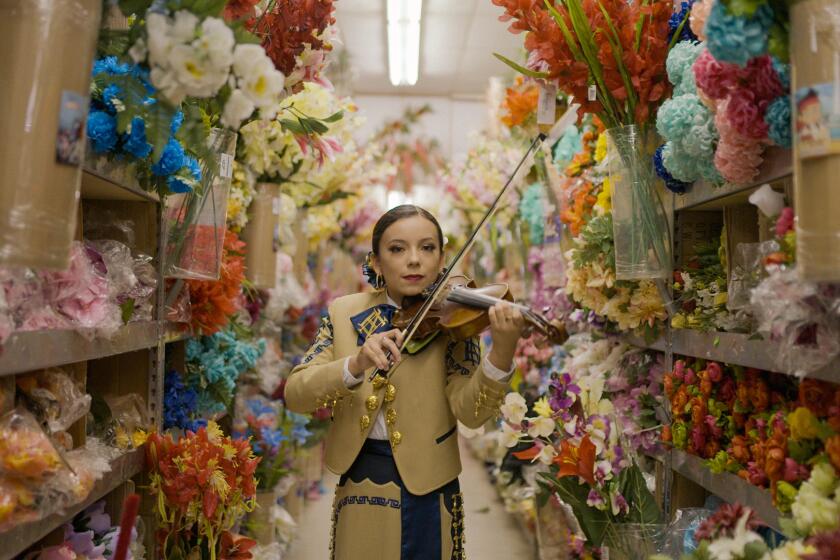
- Share via
Wendy Ramirez, co-founder of online learning website Spanish Sin Pena, saw firsthand how música Mexicana affected her students — many of whom are of Latin American descent — during a recent language immersion trip to Oaxaca, Mexico, organized by her company. At the end of a long day trip, the group sat down at a local karaoke restaurant to celebrate an instructor’s birthday. The students knew this educator loved to sing, and they wanted to show off their newfound confidence in the language by belting out some classics.
“Everyone picked a song and sang that night,” Ramirez said. “We had one of our students from Los Angeles, she was singing Juan Gabriel. It was such a fun night.”
Música Mexicana has been pushed into the mainstream over the last five years by Gen Z and millennial Latino audiences. Here’s a guide on the genre’s essential instruments, where to find the best música Mexicana-themed parties, where to shop for the perfect vaquero outfit and more.
Ramirez’s language learning service, which is meant to be a safe, nonjudgmental space for anyone trying to learn Spanish regardless of their fluency (the name translates to “Spanish without shame,” offers online classes dedicated to dissecting famous música Mexicana songs from acts like mariachi idol Vicente Fernandez and slain Tejano queen Selena Quintanilla.
Spanish Sin Pena’s music-based learning services are just one example of educators using the genre as a tool to teach both language and culture to a growing number of U.S.-born Latinos who are not fluent in their heritage language.
According to a 2023 fact sheet by the Pew Research Center, the percentage of Latinos who speak Spanish at home declined from 78% in 2000 to 68% in 2022. Among those who were born in the United States, this figure dropped from 66% to 55%.
David E. Hayes-Bautista, director of the Center for the Study of Latino Health and Culture at UCLA, says that the loss of Spanish skills among U.S. Latinos is not a recent trend, adding that cultural shaming in this country after every wave of migration from Latin America is well documented.
“We go through a phenomenon that I call the ‘Latino double impostor syndrome,’” Hayes-Bautista said. “Here in the U.S., I’ve always been too Mexican to ever be considered American. I go to Mexico and I’m too American to ever be [truly] Mexican.”
It’s this growing population of second- and third-generation Latinos — they make up the majority of the total U.S. Latino population — that Ramirez wants to help reconnect with their language and roots through music.
“We’re still building a strong community of support for one another for learning and growing with the language,” Ramirez said. “Music is something that’s already part of almost everybody’s lives. So, since the beginning, it’s been a part of our curriculum.”
‘Going Varsity in Mariachi,’ the endearing documentary about the world of competitive high school mariachi in Texas, is finally available on streaming.
Mark Yanez, a Spanish Sin Pena student, said his conversational skills and connection to his Mexican heritage became stronger after completing a session that dissected Gabriel’s lyrics and delved into his life.
He began taking online beginner and intermediate Spanish classes at the start of the pandemic. Yanez says he signed up after struggling to communicate with his grandparents during video calls he set up to learn more about their past. When he saw a class solely focused on “El Divo de Juárez,” whom his grandmother loved, he recognized the opportunity to learn the language from a master wordsmith.
“It’s changed my relationship with my mom and my grandma,” Yanez said. “Discovering Spanish through music is a way you wouldn’t think about connecting. You’re doing it through artwork.”
Guillermo Gonzalez, director of the mariachi music program at James. A Garfield High School, says that the Los Angeles Unified School District has helped students improve their Spanish and tap into their roots through K-12 mariachi classes offered in select schools. Garfield High’s mariachi program was started in the 1990s and was a staple on campus until 2008, when the district faced budget cuts. When the program returned, Gonzalez says, more than 30 students joined in the first year. Since then, it has grown to over 50 students and features an all-girl mariachi group.
“I don’t think we’re necessarily the best musicians in the world,” Gonzalez said. “But the thing I can teach them is how to love their culture. It really helps them to connect with their families and grandparents.”
Dance clubs, studios and other venues across the U.S. are partnering with social media Latino influencers to reel in a new generation of música Mexicana dancers.
Gonzalez estimates that about half of his students are not fluent Spanish speakers. This language gap, he adds, is why he works with students to understand the lyrics, sitting down with them to define unknown phrases and break down their meanings. He believes it’s important to grasp the impact of what the song is saying to authentically present their culture to audiences.
“It does open up those lines of communication,” he said. “A lot of these kids’ parents want them to come home and sing. It really gives them the confidence to not only talk but to also sing in Spanish and not worry about pronouncing something incorrectly.”
More to Read
The Latinx experience chronicled
Get the Latinx Files newsletter for stories that capture the multitudes within our communities.
You may occasionally receive promotional content from the Los Angeles Times.










